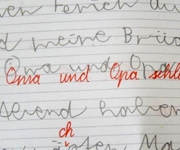 Children and teachers in need: problems with writing motor skills are on the increase.
Children and teachers in need: problems with writing motor skills are on the increase.
Many children have problems developing legible, fluid handwriting over the course of their literacy lessons in primary school, as is required as part of the nationally applicable German educational standards.

Motor skills assume fundamental significance in the process of learning to write. Scientific studies show that writing problems are primarily linked to problems in learning good writing motor skills. And writing problems are on the increase, as indicated by the 2015 national teacher survey by the Schreibmotorik Institut in cooperation with the German Union of Teachers.
According to the teachers surveyed, half of all boys (51 per cent) and a third of all girls (31 per cent) have problems with handwriting. The results of the survey clearly show that a majority of children require more support.
The issue is of particular relevance when school children make the transition to secondary school, because the demands of children’s handwriting increase considerably from Year 5. The fact that only two thirds (62%) of secondary school children are able to write for longer than 30 minutes complaint-free gives food for thought. Not least because school assessments are primarily in written form over one or two teaching periods (in Germany this is equivalent to 45–90 minutes).
Teachers also regard learning to write at primary school as an elementary component of school education. Alongside “more time in class”, “special writing motor skills training” is seen by the teachers surveyed as the most important course of action for reducing problems. It must also be ensured in the future that all children have the chance to successfully achieve the objectives set in the nationally applicable educational standards.
Studies of writing motor skills enable the identification of a whole number of favourable factors that support the acquisition and (further) development of writing skills. Additionally, initial studies (e.g. Diaz Meyer et al, 2017) show that support of writing motor skills helps children to write more rapidly and with less pressure.
The children given playful instruction in preschool have the best prospects for developing their motor skills. This means they enter primary school with a good motor skills foundation.
Further reading
Detailed survey results: Problems in handwriting development (pdf)
Federal Press Conference: The Schreibmotorik Institut in the media April 2015
MARQUARDT, C.; DIAZ MEYER, M.; SCHNEIDER, M.; HILGEMANN, R.: Learning handwriting at school – A teachers' survey on actual problems and future options, In: Trends in Neuroscience and Education (2016) 5 (3), 82-89, http://www.sciencedirect.com/science/article/pii/S2211949316300126
DIAZ MEYER, M; SCHNEIDER, M; MARQUARDT, M.; KNOPF, J.; LUPTOWICZ, C.: Schreibmotorische Förderung bei Erstklässlern: Ergebnisse einer Interventionsstudie. In: Didaktik Deutsch (2017) 43, S. 33-56.
The complete publications by the Schreibmotorik Institut
If you want to use information or contents of this article, please cite it as follows:
Schreibmotorik Institut e.V. (2017). Children and teachers in need: problems with writing motor skills are on the increase. Retrieved [Month dd, yyyy] from http://www.schreibmotorik-institut.com/index.php/en/facts-tips/expertise/514-children-and-teachers-in-need-problems-with-writing-motor-skills-are-on-the-increase

